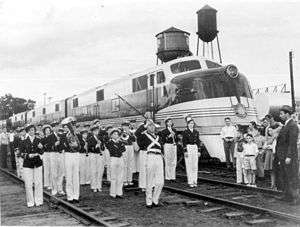EMC E4
|
SAL #3003 leads the Orange Blossom Special into Plant City, Florida, in December 1938, inaugurating diesel service in the Southeast. | |||||||||||||
| |||||||||||||
| |||||||||||||
| |||||||||||||
| |||||||||||||
The EMC E4 was a 2,000 horsepower (1,500 kW), A1A-A1A passenger train-hauling diesel locomotive built by the Electro-Motive Corporation of La Grange, Illinois. All were built for the Seaboard Air Line Railway. The E4 was the fifth model in a long line of passenger diesels of similar design known as EMD E-units.
The 2,000 hp (1,500 kW) was achieved with two EMC model 567 V12 engines developing 1,000 hp (750 kW), each engine driving its own electrical generator to power the traction motors.
The front noses of the EA, E1A, E3A, E4A, E5A, and E6A cab units had a pronounced slant when viewed from the side. Therefore, these six models have been nicknamed "slant nose" units. Later E-unit models received the same blunted "bulldog nose" as the F-units.
Ironically, the E4 was produced before the E3. Both models were identical, save for the E4 having a pneumatically-operated nose door passageway in order to facilitate crew movement between units in a locomotive consist.
All the E4s were retired and scrapped by 1964.
Original owners
| Railroad | Quantity A units | Quantity B units | Road numbers | Notes |
|---|---|---|---|---|
| Electro-Motive Corporation (demonstrator) | 1 | — | 1939 | to SAL 3013 |
| Electro-Motive Corporation (demonstrator) | — | 1 | 1939B | renumbered EMC 1940B, to SAL 3104 |
| Seaboard Air Line Railway | 13 | — | 3000–3012 | |
| Seaboard Air Line Railway | — | 4 | 3100–3103 |
See also
References
- Lamb, J. Parker (2007). Evolution of the American Diesel Locomotive. Railroads Past and Present. Bloomington, IN, USA: Indiana University Press. ISBN 9780253348630.
- Marre, Louis A. (1995). Diesel Locomotives: The First 50 Years: A Guide to Diesels Built Before 1972. Railroad Reference Series (Book 10). Waukesha, WI, USA: Kalmbach Publishing. ISBN 0890242585.
- Pinkepank, Jerry A. (1973). The Second Diesel Spotter’s Guide. Milwaukee, WI: Kalmbach Publishing Company. pp. EMD–121– to EMD–123. ISBN 0-89024-026-4.
- Schafer, Mike (1998). Vintage Diesel Locomotives. Enthusiast Color Series. Osceola, WI, USA: MBI Publishing. ISBN 0760305072.
- Solomon, Brian (2000). The American Diesel Locomotive. Osceola, WI, USA: MBI Publishing. ISBN 0760306664.
- Solomon, Brian (2006). EMD Locomotives. St. Paul, MN: Voyageur Press. ISBN 978-0-7603-2396-0.
- Solomon, Brian (2010). Vintage Diesel Power. Minneapolis, MN, USA: MBI Publishing. ISBN 9780760337950.
- Solomon, Brian (2011). Electro-Motive E-Units and F-Units: The Illustrated History of North America's Favorite Locomotives. Minneapolis, MN, USA: Voyageur Press. ISBN 9780760340073.
- Solomon, Brian (2012). North American Locomotives: A Railroad-by-Railroad Photohistory. Minneapolis, MN, USA: Voyageur Press. ISBN 9780760343708.
- Wilson, Jeff (2002). E Units: Electro-Motive's Classic Streamliners. Classic Trains / Golden Years of Railroading series. Waukesha, WI, USA: Kalmbach Publishing. ISBN 0890246068.
External links
-
 Media related to EMC E4 locomotives at Wikimedia Commons
Media related to EMC E4 locomotives at Wikimedia Commons
